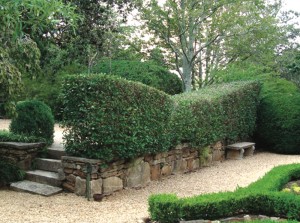From The Garden. Tea, Anyone?

Some plants, like some people, become more interesting when one finds out about their past. Such is the case with the shrub Camellia sinensis at Hills & Dales Estate. In its most prominent site, it is cultivated as a v-shaped hedge, and like most broadleaved evergreen shrubs, it is quiet and unassuming, causing most passers-by to pay it only the most cursory attention. Its shape is what most visitors seem to notice more that any other attribute. Only when they discover its true identity do they give it more consideration, for Camellia sinensis is the tea plant.
First of all, it is surprising to some that the source for tea leaves is a Camellia. Most visitors know the genus primarily for its showier species, the sasanquas and japonicas—famous for their spectacular blooms during fall and winter. Native to China, Camellia sinensis began lending its leaves for the making of beverage in that country nearly 5000 years ago, its popularity giving rise to various legends about its brewing. One of the most widely accepted stories involves brown leaves from one of the shrubs blowing into a cup of hot water belonging to Emperor Shen Nung, the resulting aromatic liquid being consumed by him and its invigorating effects being noted. It would be hard to identify another plant’s contribution to world events that would overshadow that of tea; although, its conquest was not overnight.

The tea hedge, on the 4th terrace above the God topiary is kept sheared. this planting was put in by Mrs. Alice Callaway and has remained healthy and handsome for many years.
It took nearly 2000 years for the consumption of tea to become firmly established in China and then a few hundred more before it was introduced to Japan, where a whole culture eventually surrounded the brewing and serving of tea in an elaborate ceremony. Another 500 years or so elapsed before the drink reached the cups of Europe, when Portuguese and Dutch traders began shipping it west late in the 16th century. As consumption inevitably increased, tea became the important commodity that it still is today. The history of its impact looms large in the annals of the East India Company, tea smuggling, the American Revolution (remember the Boston Tea Party?) and Clippers, the famous racing ships that came into being to speedily deliver tea to its consumers.
Camellia sinensis is the source of leaves for black, oolong, green, and white tea. The difference in the type of tea produced depends on the size and age of the leaves harvested as well as how they are processed after they are picked. All teas made from Camellia sinensis contain caffeine and flavonoids. Flavonoids are antioxidant substances purported to have various health benefits. Tea processed from the youngest plant parts that are not allowed to oxidize delivers the highest concentration of flavonoids. Due to the ever-increasing media hype surrounding the value of consuming foods rich in antioxidants, tea as a beverage is perhaps more popular now than ever. Some sources report its world wide consumption as being second only to water. That is saying a lot.
Tea has been grown in our garden since the 1800’s, its cultivation begun by Sarah Ferrell, the founder of the historic Ferrell Gardens at Hills & Dales Estate. In an 1888 Montgomery, Alabama, newspaper article about the Terraces (as Ferrell Gardens was known then) is the following description: “…a spot given over to flowers. In it is a large China tea plant—extremely rare in this country.” Whether Mrs. Ferrell ever harvested any leaves and brewed her own tea is open for speculation, but apparently the Callaway family did. Newspaper articles dating back as early as 1916 mention the practice of harvesting tea leaves from this garden to produce tea for the family’s table. Tea grows well in the South and cultivation of it as an agronomic crop in the US was first initiated in the 18th century. However, it was, and still is, only produced in relatively small quantities.
“One of the unsung treasures of the camellia world for use in zone 7 to 9 gardens.”
– Michael Dirr
Manual of Woody Landscape Plants
Gardeners in this country often treat Camellia sinensis as an ornamental shrub. Michael Dirr in his Manual of Woody Landscape Plants calls it “one of the unsung treasures of the Camellia world for use in Zone 7 to 9 gardens.” As mentioned earlier, it is an evergreen, having leaves that are glossy and dark green and blossoms which are deliciously scented. Should you want to include it in your landscape, it is an excellent hedge, either grown loose and unclipped or sheared formally, as well as being an appropriate addition to an herb garden or container grouping. If not, you can always come and admire ours.